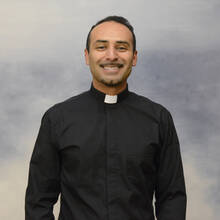Easter: The Feast of Humility
On Easter morning, there is a rush among the disciples closest to Jesus to figure things out. What follows is general confusion and a lesson that must be relearned by every generation of new disciples: The Easter experience is one that unfolds slowly and deliberately.
Clear out the old yeast, so that you may become a fresh batch of dough, inasmuch as you are unleavened. (1 Cor 5:7)
What is the “old yeast” in your life that you can let go of today?
Where is the invitation for renewal in light of the Easter experience?
Are you rushing to “see and believe” like the early disciples?
The readings for Easter Sunday have everyone running. A startled Mary of Magdala reacts to the stone removed from Jesus’ tomb. “So she ran and went to Simon Peter and to the other disciple whom Jesus loved” (Jn 20:2). Then those two, Peter and “the other disciple” start running towards the tomb to “witness” for themselves what this might mean. As the fourth Gospel describes this scene, what unfolds is a dramatic race to the tomb. “They both ran, but the other disciple ran faster than Peter” (Jn 20:4). There is a prize for the fastest one. The “other disciple” arrives first to the tomb and waits for Peter. This faster one then goes into an empty tomb where “he saw and believed” (Jn 20:8).
Meanwhile, the text is enigmatic in describing the way Peter processes his experience of the empty tomb. Did Peter come to “see and believe” immediately like the other disciple? The only thing the Gospel explains is a general ignorance about what happens next, “For they did not yet understand the Scripture that he had to rise from the dead” (Jn 20:9). In this case, the fourth Gospel agrees with an earlier passage during Lent from the Gospel of Mark. After the scene where Jesus reveals his glory on the mountain of Transfiguration, the disciples learn that Jesus must rise from the dead. “They kept the matter to themselves,” reads the text, “questioning what this rising from the dead could mean” (Mk 9:9).
In our own process of “seeing and believing” in the resurrection, it might be helpful to leave behind what no longer serves to deepen one’s faith. Paul speaks about this in terms of what might be understood as downward mobility, that is, what aids our faith is to deflate one’s ego in the spirit of sincerity and truth. The opposite would be to inflate our pride with malice.
In this Sunday’s second reading, we have what might be the earliest recorded Easter homily. In it, Paul compares leavened bread with unleavened. Paul suggests the image of “a little bad yeast” that leavens a whole batch of dough. Extended metaphorically, such leavening is any agent that can corrupt an individual or a whole community of faith (see 1 Cor 5:6). If Paul is writing around the time of Passover, he is referring to the Feast of Unleavened bread that follows Passover in the Jewish calendar. The advice is clear: “Clear out the old yeast, so that you might become a fresh batch of dough, inasmuch as you are unleavened” (1 Cor 5:7). Why does Paul recommend becoming like the unleavened? Because the Christian Passover represents a full life reset, one that requires a new heart, mind, and behavior. Just as Jewish householders scrupulously cleaned out every shred of leavening agents in the week before passover, which resulted in new, unleavened bread, so Christians had to scour themselves within and without to make room for the new agency of Christ.
Paul’s words still encourage us today. May we celebrate this feast not with the old yeast that inflates one’s ego, but with unleavened bread that represents the integrity and truth we learn through grace. This is a slow and deliberate process. To “see and believe” in the power of the resurrection requires the practice of humility. If Christians boast about anything today, let it be about their growth in humility as they have come to believe in the mystery of rising from the dead.








